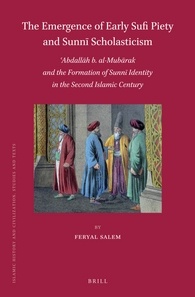The author
Feryal Salem, Ph.D. (University of Chicago, 2013) is Assistant Professor of Islamic Scriptures and Law at the Macdonald Center for the Study of Islam and Christian-Muslim Relations at Hartford Seminary. She is also Associate Editor of The Muslim World and directs the Islamic Chaplaincy Program.
Presentation

In the figure of ʿAbdallāh b. al-Mubārak (118–181/736–797), we find a paragon of the fields of ḥadīth, zuhd, and jihād, as attested to by the large number of references to him in the classical Islamic texts. His superior rank as a ḥadīth transmitter earned him the title of “commander of the faithful” in ḥadīth among many later critics. He also contributed to Islamic law at its early phases of development, was a practitioner of jihād, composed poetry, and participated in various theological discussions. In addition, Ibn al-Mubārak was a pioneer in writing on piety and he was later regarded by many mystics to be one of the earliest figures of Sufism. Ibn al-Mubārak’s position during the formative period of Islamic thought illustrates the unique history of the evolution of zuhd, ḥadīth, and jihād which forms a junction in the biography Ibn al-Mubārak in a way that distinctively illuminates the second/eighth-century dynamics of nascent Sunnism. Furthermore, Ibn al-Mubārak’s status as a fighter and pious figure of the Late Antique period reveals a great deal about the complex relationship between the early Muslim community and the religiously diverse setting which they inhabited. This monograph on the figure of ʿAbdallāh b. al-Mubārak examines his life both critically and comprehensively while situating him within the larger context of the social and religious milieu of Late Antiquity. It explores the formation of Sunni identity in the second Islamic century and demonstrates the way in which it manifests through networks of pious scholars who define, preserve, and pass on what they understand to be normative Islamic practice and beliefs from one generation of Muslim intellectuals to another.
Contents
Contents
Acknowledgments
Introduction
Chapter 1: Biography of ʿAbdallāh b. al-Mubārak
The Sources of Ibn al-Mubārak’s Biography
ʿAbdallāh b. al-Mubārak: His Life and Career as Presented in Classical Texts
Ibn al-Mubārak’s Recording Ḥadīths through Writing
Ibn al-Mubārak the Merchant
Ibn al-Mubārak’s Fiqh
Ibn al-Mubārak’s Theology
Ibn al-Mubārak’s Jihād
Ibn al-Mubārak’s Role in Ḥadīth Transmission
Ibn al-Mubārak’s Zuhd
Chapter 2: ʿAbdallāh b. al-Mubārak and Ḥadīth
Ibn al-Mubārak’s Role in Ḥadīth Transmission
Ibn al-Mubārak’s Unpublished Books
Ibn al-Mubārak’s Published Works
Teachers and Students of ʿAbdallāh b. al-Mubārak
Ibn al-Mubārak’s Teachers
Prominent Students of Ibn al-Mubārak
Ibn al-Mubārak and the Ḥadīth Networks in the Second/Eighth Century
Chapter 3: Jihād in the Career of Ibn al-Mubārak
The Thughūr Before Ibn al-Mubārak
Ibn al-Mubārak’s Martial Pursuits as Depicted in the Classical Sources
Ibn al-Mubārak’s Kitāb al-Jihād
Transmitters of the Kitāb al-Jihād
Intentions and Jihād
Chapter 4: Ibn al-Mubārak and His Zuhd
What is Zuhd?
Ibn al-Mubārak: The Rich Ascetic
Ibn al-Mubārak’s Kitāb al-Zuhd
Analysis of the Kitāb al-Zuhd
The Genre of Books on Zuhd (Kutub al-Zuhd)
Chapter 5: Conclusion
Bibliography
Index
